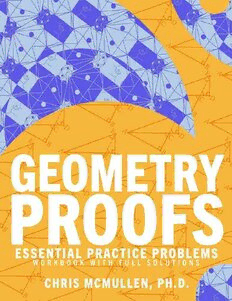
Geometry Proofs Essential Practice Problems Workbook with Full Solutions PDF
Preview Geometry Proofs Essential Practice Problems Workbook with Full Solutions
Essential Practice Problems Workbook with Full Solutions Chris McMullen, Ph.D. monkeyphysicsblog.wordpress.com improveyourmathfluency.com chrismcmullen.com Introduction 1 Terminology 2 Notation 3 Concepts 4 Strategy 5 Examples 6 Proofs 7 Hints 8 Solutions About the Author INTRODUCTION This workbook is designed to help students practice writing geometry proofs. The early chapters review terminology, notation, and the underlying principles. Another chapter outlines the strategy and offers tips. Nine fully-solved examples are provided to help serve as a guide. Each of the exercises is fully solved in the back of the book. This book focuses on plane Euclidean geometry. Standard topics are included, such as: • parallel lines and transversals • alternate interior angles • similar and congruent triangles • circles, chords, and tangents • quadrilaterals • the Pythagorean theorem • regular polygons • interior and exterior angles • complements and supplements • area of plane figures • inscribed and circumscribed • the centroid of a triangle May you (or your students) find this workbook helpful and improve your fluency in writing geometry proofs. 1 TERMINOLOGY A straight line extends infinitely in each direction. A line segment is a portion of a straight line: it connects two points. The line segment is finite. It doesn’t extend beyond its endpoints. A ray has an endpoint at one side, but extends infinitely in the other direction. An angle forms when two lines intersect. (In this case, it doesn’t matter if they are lines, line segments, or rays. Although if they are both lines, they technically form four angles.) Angular measure refers to the numerical value that you would obtain (in degrees or radians) if you measured the angle with a protractor. Angular measure represents a number, whereas angle refers to a geometric figure (it is a visual representation). A vertex is the point where two lines intersect. (In this case, it doesn’t matter if they are lines, line segments, or rays.) The plural form of this term is vertices. One degree is an angular measure corresponding to 1/360 of a complete circle. One radian is an angular measure defined such that radians corresponds to 180°. A right angle has an angular measure of 90°. One way to form a right angle is to draw one quarter of a circle. An acute angle has an angular measure that is less than 90°. An obtuse angle has an angular measure that is greater than 90°. Parallel lines extend in the same direction and are the same distance apart at any position (such that they will never intersect). Intersecting lines meet at some point. When only a portion of each line is drawn, you may need to imagine extending the lines in order to visualize the point of intersection. Perpendicular lines intersect at a right angle. They form a 90° angular measure. Two lines are askew if they are neither parallel nor intersecting. Two lines that lie in the same plane can’t be askew, but it is possible for two nonplanar lines in space to be askew. (However, it is possible for two coplanar line segments to be askew. Recall that a line segment is finite, whereas a line extends infinitely.) Complementary angles form a right angle. Their angular measures add up to 90°. Supplementary angles form straight line. Their angular measures add up to 180°. Vertical angles form on opposite sides of a vertex when lines intersect. Vertical angles are congruent. A plane is an infinitely large, flat, two-dimensional shape. Imagine an infinitely large rectangle (or even a circle) as that would form a plane. A polygon is a closed plane figure with straight edges. An equilateral polygon has sides with the same length. An equiangular polygon has interior angles with the same angular measure. A regular polygon is both equilateral and equiangular. An interior angle forms at the vertex of a polygon and lies inside of the polygon. An exterior angle is formed by one edge of a polygon and a line that extends from an adjacent edge. For a convex polygon, the measure of all of the interior angles is less than 180°. For a concave polygon, at least one interior angle is greater than 180°. Some common polygons include the triangle (3 sides), quadrilateral (4 sides), pentagon (5 sides), hexagon (6 sides), heptagon (7 sides), and octagon (8 sides).
